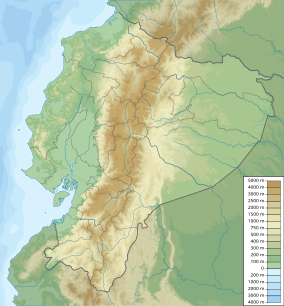Llanganates National Park
| Llanganates National Park | |
|---|---|
IUCN category II (national park) | |
 High elevation páramo at Llanganates NP | |
| Location | Ecuador Cotopaxi Province, Napo Province, Pastaza Province and Tungurahua Province. |
| Coordinates | 1°8′0″S 78°14′0″W / 1.13333°S 78.23333°W |
| Area | 219,707 ha |
| Established | January 18, 1996 |
Llanganates National Park (Spanish: Parque Nacional Llanganates) is a place in Ecuador. It is a place for plants, animals, and other living things to live. It is in the Cotopaxi Province, Napo Province, Pastaza Province, and Tungurahua Province. A mountain called Cerro Hermoso ("beautiful mountain") is in the park. It is 4,570 meters (14,990 ft) high. Hikers like to come to the park to climb it. The park is famous for the Treasure of the Llanganatis.
Visitors come to the park from towns, for example Salcedo, Patate, Pillaro, Baños, and Rio Verde.
Ecology
[change | change source]The park has two different places in it. The west part of the park is in the Andes mountains. It is a special kind of forest called a páramo. This is much higher up than the east part of the park. There are high mountains and high valleys. Only a few plants and animals live there, for example South American camelids like vicuñas, llamas, and alpacas.
The east part of the park has mountain forests with many different kinds of plants and animals. It is hard to get to this place. Human beings can only go by walking, not with cars or planes. There are many rivers. Scientists found many species of plants that no scientist had written about before, for example many Andean Magnolia plants.[1][2][3][4]
Exploration
[change | change source]In 2013, people from Ecuador, Britain, France, and America found and dug up a 260 ft tall by 260 ft wide stone thing. They saw it had hundreds of two-ton stone blocks in it. Scholars think there could be more things like this nearby. They found the stone thing 20 miles from the town of Baños, but it takes eight hours to get there because there are mountains and jungles in the way. They found it 8,500 ft above sea level in cloud forest.[5]
References
[change | change source]- ↑ Vázquez-García, J.-Antonio; Neill, David A.; Asanza, Mercedes (2015-06-22). "Magnolia vargasiana (Magnoliaceae), a new Andean species and a key to Ecuadorian species of subsection Talauma, with notes on its pollination biology". Phytotaxa. 217 (1): 26. doi:10.11646/phytotaxa.217.1.2. ISSN 1179-3163.
- ↑ OROZCO, CLARA INÉS; PÉREZ, ÁLVARO J.; ROMOLEROUX, KATYA; ALDANA, JOSÉ MURILLO (2017-06-30). "The discovery of a new species of Brunellia (Brunelliaceae) with ephemeral petals from Llanganates National Park, Ecuador". Phytotaxa. 311 (3): 263. doi:10.11646/phytotaxa.311.3.6. ISSN 1179-3163.
- ↑ Vázquez-García, J. Antonio; Neill, David A.; Recalde, Fausto; Asanza, Mercedez (2016-09-08). "Magnolia llanganatensis (Subsect. Talauma, Magnoliaceae), una especie nueva de Tungurahua y clave para las especies de Magnolia de Ecuador". Botanical Sciences. 94 (3): 593. doi:10.17129/botsci.435. ISSN 2007-4476.
- ↑ VÁZQUEZ-GARCÍA, J.-ANTONIO; NEILL, DAVID A.; SHALISKO, VIACHESLAV; ARROYO, FRANK; MERINO-SANTI, R. EFRÉN (2018-05-04). "Magnolia mercedesiarum (subsect. Talauma, Magnoliaceae): a new Andean species from northern Ecuador, with insights into its potential distribution". Phytotaxa. 348 (4): 254. doi:10.11646/phytotaxa.348.4.2. ISSN 1179-3163.
- ↑ Copping, Jasper (15 Dec 2013). "Explorers hot on the trail of Atahualpa and the Treasure of the Llanganates". The Telegraph. Retrieved 19 June 2014.
Other websites
[change | change source]- www.murcielagoblanco.com / List of mammals in the Llanganates National Park[permanent dead link] (Spanish)
- www.birdlife.org / List of birds in the Llanganates National Park (Spanish / English)
- / Attractions of the Llanganates (Spanish) Archived 2009-02-25 at the Wayback Machine

